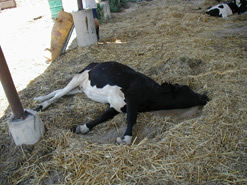| Botulism |
Etiology Botulism is caused by botulinum toxin, a potent neurotoxin produced by Clostridium botulinum and a few strains of C. baratii and C. butyricum. Clostridium botulinum is an anaerobic, Gram-positive, spore-forming rod. Transmission C. botulinum and its spores are widely distributed in soils, sediments in fresh and coastal waters, the intestinal tracts of fish and mammals, and the gills and viscera of shellfish. The bacteria can only grow under anaerobic conditions. Botulism occurs when animals ingest preformed toxins in food or C. botulinum spores germinate in anaerobic tissues and produce toxins as they grow.
Clinical Signs Foodborne Infections In foodborne infections, gastrointestinal disturbances including nausea, vomiting and abdominal pain are often the first sign. Either diarrhea or constipation may occur. As the disease progresses, a symmetric, descending flaccid paralysis develops in the motor and autonomic nerves. The clinical signs may include blurred or double vision, photophobia, drooping eyelids, slurred speech, dysphagia, urine retention, a dry mouth and muscle weakness. In untreated progressive infections, descending paralysis of the respiratory muscles, arms and legs is seen. Fatal respiratory paralysis may occur within 24 hours in severe cases. Fever is not usually seen. Treatment and Vaccination Supportive treatment, with respiratory support if necessary, is the cornerstone of treatment. Botulinum antitoxin, given early, may prevent the disease from progressing and decrease the duration of symptoms. In foodborne illness, the amount of toxin in the gastrointestinal tract can be reduced with stomach lavage and enemas. Antibiotics and debridement are used in cases of wound botulism. Antibiotics are also used occasionally in foodborne cases, but are not generally recommended in infant botulism as they may change the intestinal flora. Investigational vaccines may be available for humans who have a high risk of exposure. |
References:
|



